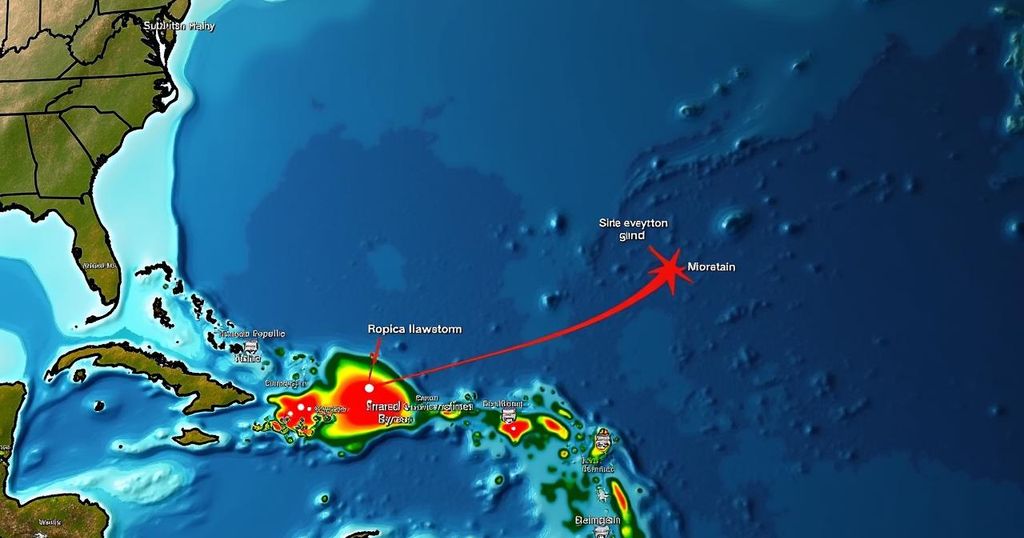Tropical Storm Milton: Impending Threats and Forecasted Impact on Florida

The emergence of Tropical Storm Milton poses potential threats to Florida, with forecasts indicating hurricane-strength winds and heavy rain by Wednesday. Following closely on the heels of Hurricane Helene, which caused significant fatalities, Milton highlights ongoing concerns regarding severe weather patterns during this hurricane season, which may produce up to 25 storms, including several major hurricanes.
Tropical Storm Milton has emerged, tracking across the Gulf of Mexico, with forecasts indicating it may deliver hurricane-strength winds and significant rainfall to Florida by Wednesday, as reported by the National Hurricane Center. This storm marks the thirteenth named entity of the hurricane season. Historically, the ramifications of hurricanes and tropical storms extend beyond the immediate vicinity of landfall. If Tropical Storm Milton maintains its current course and escalates into hurricane status, it will represent the second such landfall in Florida within a fortnight, following Hurricane Helene, which impacted the region as a Category 4 storm, resulting in record-high storm surges and over 220 fatalities along its path from Florida to Virginia. Tropical cyclones in the Atlantic Ocean require specific criteria to develop into defined weather systems. Meteorologists from the National Hurricane Center monitor wind speeds closely, as they dictate the classification of the storm. A wind speed of 39 mph for one minute designates the storm as a tropical storm, while 74 mph elevates it to Category 1 hurricane status, continuing to a maximum of Category 5. These classifications are crucial for predicting potential risks and damage, enabling timely warnings regarding strong winds, elevated waves, heavy rains, and consequent flooding upon landfall. The peril of encountering tropical storm-force winds cannot be understated, as hurricane-force winds possess the capability to devastate buildings and hurl debris across extensive areas. The winds also exacerbate the phenomenon known as storm surge, which leads seawater inland, the primary cause of hurricane-related fatalities in the United States, as outlined by the National Weather Service. Additionally, large waves pose significant threats to both civilian safety and property. As the storm advances inland, flooding emerges as a substantial concern. Cyclones frequently produce excess rainfall, exceeding six inches, which can overwhelm drainage systems and saturate the ground beyond its capacity to absorb, culminating in flash floods that may persist long after the storm has passed. The hurricane season typically reaches its apex around mid-September. The current season holds the potential for it to be one of the most severe in recent history, with the National Oceanic and Atmospheric Administration projecting between 17 and 25 tropical storms, of which four to seven could escalate into major hurricanes. Hurricane Helene has been documented as one of the most lethal hurricanes of contemporary times, illustrating the increasing severity and lingering nature of storms as highlighted by recent studies.
Tropical storms and hurricanes pose significant threats to coastal regions, with meteorologists and governmental bodies focusing on tracking and predicting these systems to mitigate potential damage. The formation and classification of hurricanes are key to understanding their possible impact, as well as to establish effective preparation and response measures. The historical context of hurricane seasons indicates a rising trend in storm intensity and frequency, necessitating heightened vigilance amid changing climatic conditions.
In summary, Tropical Storm Milton is predicted to affect Florida soon, potentially escalating to hurricane status, which would mark it as the second landfalling storm in the state in a short period. The accompanying hazards, including strong winds, storm surge, and extensive rainfall, underscore the importance of preparedness as hurricane season remains critically active. Moreover, the rising trend in storm intensity calls for continuous monitoring and responsive actions from both authorities and residents along at-risk regions.
Original Source: www.washingtonpost.com





